Longevity and Anti-senescence Therapy Market Statistics - 2030
The global longevity and anti-senescence therapy market was valued at $25.1 billion in 2020, and is projected to reach $44.2 billion by 2030, growing at a CAGR of 6.1% from 2021 to 2030. Slowing the breakdown of skin and also stopping the development of age-related diseases are areas that have the broad impacts on human health and medicine. The anti-aging research has focused on understanding and finding ways to manipulate the metabolic pathways. These pathways are implicated in the progressive decline of biological function associated with senescence. Some of the research in the process of aging treatment includes the generation of free radicals that cause oxidative stress.
Reactions in which free radicals are released within cells in significant quantities can result in the oxidation of proteins and other cellular components, which can trigger programmed cell death. Other such research in the process of aging treatment includes longevity and that has revealed important information about diseases and aging is cardiovascular diseases treatment with calorie restriction. Moreover, stem cells also play a significant role in organ homeostasis and regeneration, and these functions can be impaired by aging. The transplantation of embryonic stem cells (stem cells derived from the inner cell mass of a mammalian embryo) may have beneficial effects in treating aging-associated conditions such as Parkinson disease.
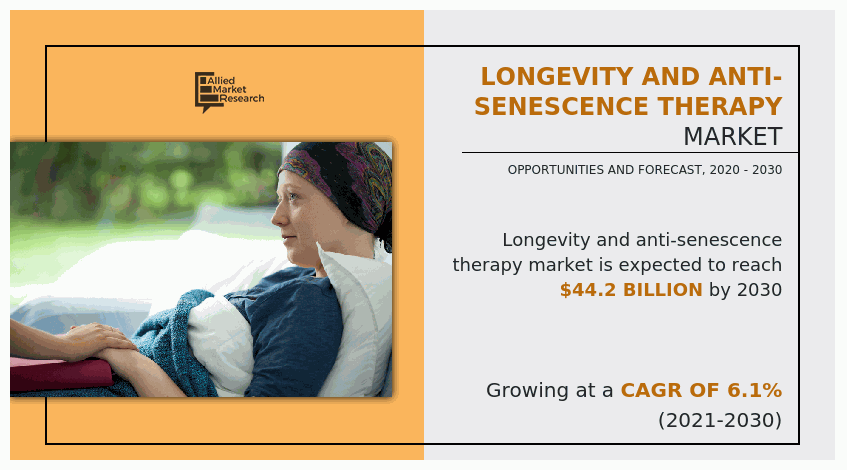
The growth of the longevity and anti-senescence therapy market size is driven by increase in prevalence of chronic diseases, rise in awareness about anti-aging products, and advancements in AI driven medical technology. Moreover, increase in geriatric population and increase in the demand for personalized, precise, preventive, and participatory aging treatments contribute toward the growth of the market. However, the dearth of skilled professionals and loss of tissue-repair capacity are expected to hinder the market growth. Conversely, increase in demand for cell-based assays in R&D is expected to provide lucrative opportunities for the longevity and anti-senescence therapy industry growth.
Coronavirus (COVID-19) was discovered in late December in Hubei province of Wuhan city in China. The disease is caused by a virus, namely, severe acute respiratory syndrome coronavirus 2 (SARS-CoV-2), which is transmitted among humans. Amid the initial outbreak of COVID-19, number of patients to undergo implant surgery declined, owing to the fear of infection during the pandemic. Moreover, the demand for anti-aging treatment products was reduced. The production plants of the antiaging products were shut down during the lockdown imposed by the governments across the globe. In addition, lockdown created a financial crisis among the market players. This led to disturbances in import and export of antiaging products across the countries. It was slightly positive amidst the COVID-19 pandemic with increase observed in the prevalence of cardiovascular diseases, neural degenerative diseases, ophthalmology disorders, and cancer. For instance, according to the data of American Heart Association, in 2020, average person in the U.S. has a stroke every 40 seconds, accounting for one out of every 19 deaths. Overall, COVID-19 negatively impacted the longevity and anti-senescence therapy market. This was attributed to decrease in demand for antiaging treatment products. Moreover, market players reduced investment in raw materials and resources, owing to decrease in number of hospital admissions of patients to undergo antiaging treatment.
The global longevity and anti-senescence therapy market share is segmented on the basis of therapy, application, end user and region. Depending on therapy, it is categorized into senolytic drug therapy, gene therapy and immunotherapy. On the basis of application, the market is classified as cancer and others. According to end user, it is classified into hospitals and medical service institution. Region wise, it is analyzed across North America, Europe, Asia-Pacific, and LAMEA.
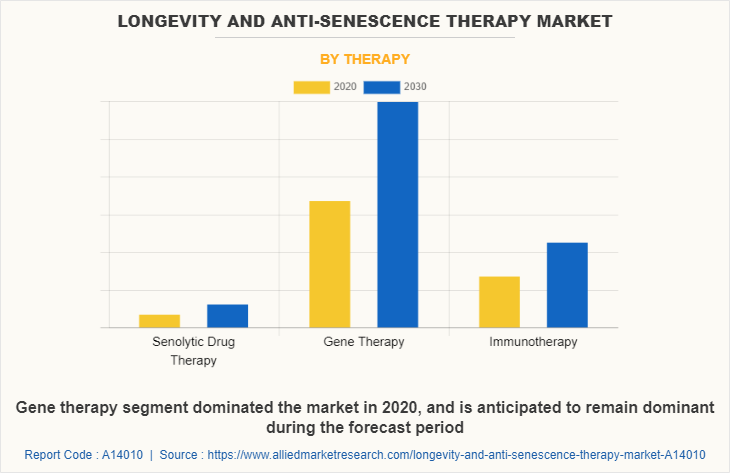
Therapy Segment Review
Depending on therapy, the market is classified as senolytic drug therapy, gene therapy and immunotherapy. Gene therapy segment dominated the market in 2020, and is anticipated to remain dominant during the forecast period, due to increase in awareness about longevity and anti-senescence therapy, rise in prevalence of the chronic diseases, and effective product launches.
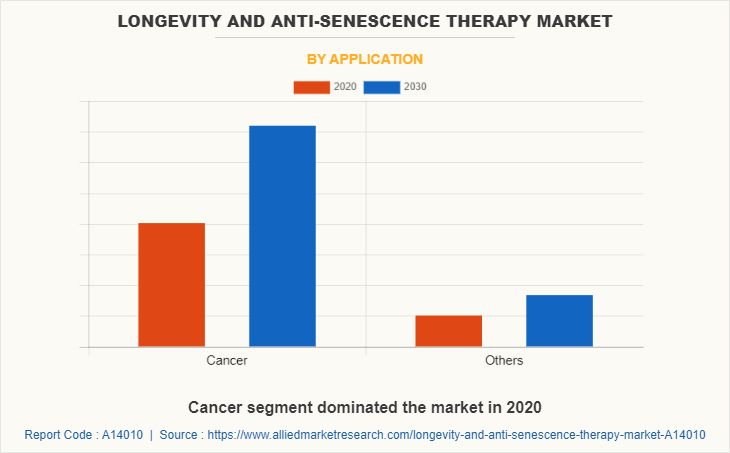
Application Segment Review
Depending on the application, the market is classified as cancer and others. Cancer segment dominated the market in 2020, and is anticipated to remain dominant during the forecast period, due to increase in geriatric population and increase in demand for personalized, precise, preventive, and participatory aging treatments.
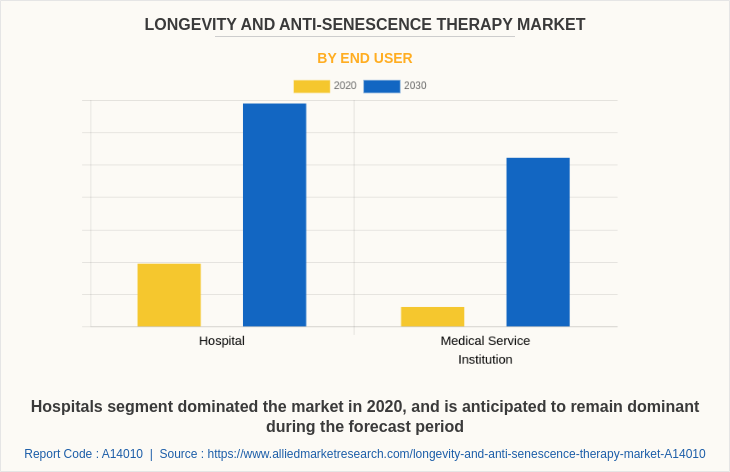
End-user Segment Review
According to end user, the Longevity Market is classified as hospitals and medical service institution. Hospitals segment dominated the market in 2020, and is anticipated to remain dominant during the forecast period, due to high usage of anti-aging products in hospitals for chronic diseases and advancements in AI driven medical technology.
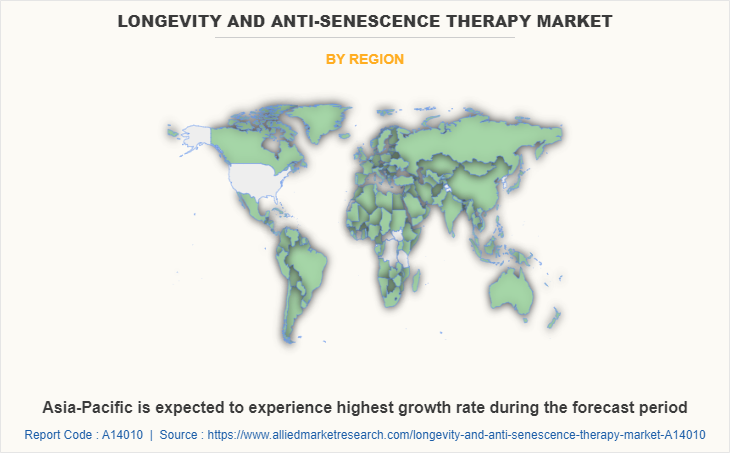
Region Segment Review
North America dominated the Longevity Market in 2020, and is expected to remain dominant throughout the forecast period. This is attributed to increase in incidence of chronic heart diseases, surge in demand for antiaging products, rise in availability of advanced healthcare facilities with trained medical professionals, surge in number of R&D activities along with presence of key players, and growth in government investments in healthcare system. However, Asia-Pacific is expected to experience highest growth rate during the forecast period. Moreover, Japan and China are expected to grow at the highest CAGR in Asia-Pacific region, due to improvement in healthcare infrastructure, rise in number of hospitals equipped with advanced instruments, development of the R&D sector, rise in healthcare reforms, and technological advancements in the field of longevity and anti-Senescence therapy market forecast.
Key Benefits For Stakeholders
- This longevity and anti-senescence therapy market growth report provides a quantitative analysis of the market segments, current trends, estimations, and dynamics of the longevity and anti-senescence therapy market analysis from 2020 to 2030 to identify the prevailing longevity and anti-senescence therapy market opportunity.
- The Longevity Market research is offered along with information related to key drivers, restraints, and opportunities.
- Porter's five forces analysis highlights the potency of buyers and suppliers to enable stakeholders make profit-oriented business decisions and strengthen their supplier-buyer network.
- In-depth analysis of the longevity and anti-senescence therapy market segmentation assists to determine the prevailing market opportunities.
- Major countries in each region are mapped according to their revenue contribution to the global longevity and anti-senescence therapy industry.
- Market player positioning facilitates benchmarking and provides a clear understanding of the present position of the market players.
- The report includes the analysis of the regional as well as global longevity and anti-senescence therapy market trends, key players, market segments, application areas, and market growth strategies.
Longevity and Anti-senescence Therapy Market Report Highlights
| Aspects | Details |
| By Therapy |
|
| By Application |
|
| By End user |
|
| By Region |
|
| Key Market Players | Pfizer Inc., AgeX Therapeutics, Inc., Bristol-Myers Squibb Company, Life Biosciences, Inc., Unity Biotechnology, Inc., Calico Life Sciences LLC, T.A. Sciences, Inc., CohBar, Inc., Oisin Biotechnologies, Merck & Co., Inc. |
Analyst Review
The involvement of cell senescence in aging and development of many age-related diseases have stimulated efforts to develop a number of strategies aimed at eliminating senescent cells and limiting their deleterious effects. North America is projected to be the highest revenue contributor, whereas Asia-Pacific is expected to offer lucrative opportunities to key players in this market.
Increase in prevalence of chronic diseases, rise in awareness about antiaging products, and advancements in AI driven medical technology drive the growth of the longevity and anti-senescence market. Moreover, increase in geriatric population and increase in demand for personalized, precise, preventive, and participatory aging treatments drive the market growth. However, dearth of skilled professionals and loss of tissue-repair capacity impede the market growth. Moreover, the increase in demand for cell-based assays in R&D are expected to provide lucrative growth opportunities for key players.
Increase in R&D for the development of novel drugs and identifying major plant components for testing its impact on longevity
Gene Therapy is the leading application of Longevity and Anti-senescence Therapy Market
North America is the largest market due to increase in incidence of chronic heart diseases, surge in demand for antiaging products, rise in availability of advanced healthcare facilities with trained medical professionals, surge in number of R&D activities along with presence of key players, and growth in government investments in healthcare system.
The estimated industry size of longevity and anti-senescence therapy market is $25,087.3 million in 2020
AgeX Therapeutics, Inc., Oisin Biotechnologies and Pfizer, Inc. hold the market share in longevity and anti-senescence therapy
Loading Table Of Content...



